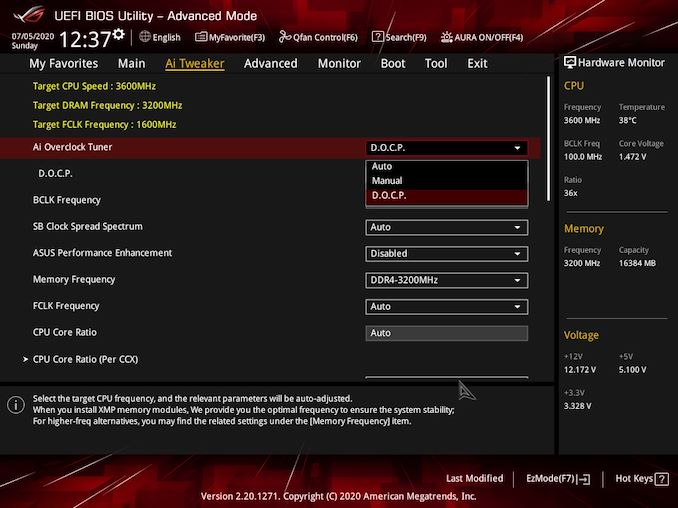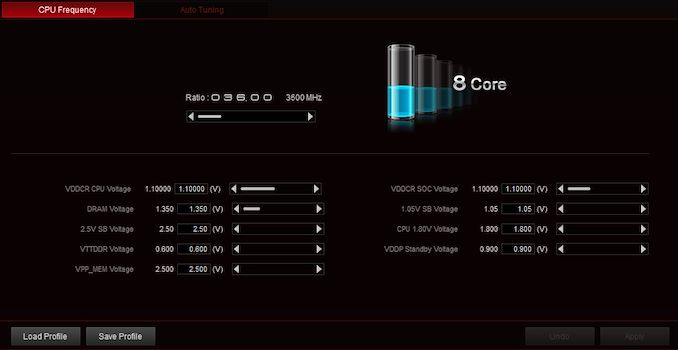The ASUS ROG Strix B550-F Gaming Wi-Fi Motherboard Review: Premium Value
by Gavin Bonshor on July 22, 2020 9:00 AM EST- Posted in
- Motherboards
- AMD
- Asus
- ROG
- AM4
- Strix
- Ryzen 3000
- Ryzen 3700X
- B550
- B550-F
BIOS
The ASUS Republic of Gamers firmware has two different modes for users to select between in the BIOS: EZ and Advanced. The basic 'EZ' mode is for novice users looking to make basic alterations. This includes basic XMP support (which ASUS calls DOCP on its AMD based models). On the basic screen is a list of core information including fan profile speeds, DRAM status, model and firmware version, current CPU Core voltage and motherboard temperature. The design of the firmware includes a dark grey background with white text and red highlights across the top and bottom of the GUI.
Pressing the F7 key allows users to switch between the EZ and the advanced mode, with the advanced more opening up the more familiar features and functions of its ROG based models. There's plenty of overclocking customizations on offer which is typical of an ASUS ROG board, with all of the available overclocking options within the Ai Tweaker section. Here users can customize the CPU settings including CPU frequency in 100 MHz increments, CPU VCore voltages, as well as a host of memory settings including memory voltage, and a section dedicated to memory latencies. One of the main features of AMD's Ryzen 3000 series is Precision Boost Overdrive, and ASUS has included it sown section within the AI Tweaker for users to customize, which allows users to create more aggressive boost profiles.
ASUS has one of the most consistent firmware within the industry, and the Republic of Gamers BIOS on the Strix B550-F Gaming Wi-Fi is a good example of this. The firmware itself is solid and reliable, is responsive to USB keyboard and mice, and is very well laid out and easy to navigate.
Software
One of the unique ASUS implementations to its Republic of Gamers branded motherboards is the Armory Crate, which is pooled into memory on the motherboard and contains basic networking drivers and all the software and utilities. Armory Crate pops up when Windows is first installed, so it looks like somehow ASUS has got into your install image! Thankfully this is just some extra software that helps most users get hold of chipset and controller drivrs as need. If can be disabled in the BIOS if needed. Note this means that the Driver CD traditionally bundled with a motherboard isn't really needed, as long as you have an internet connection.
Some of the most notable utilities in the ASUS package include the ASUS AI Suite 3 software, the ROG Gamefirst VI software, a custom skinned version of the CPU-Z monitoring utility, and its RAMCache III software.
The ASUS AI Suite 3 utility is an amalgamation of various version of its software with functions for overclocking the processor, creating custom fan curve profiles, and changing power delivery power settings. Users can overclock the processor including core voltages including SoC voltage and memory voltages, but users cannot adjust the memory frequency outside of the BIOS. The ASUS AI Suite 3 also allows users to change the fan curve profiles, or even create new ones with more aggressive settings for cooler temperatures, or more subtle settings for less noise.
Also included in the software bundle is a custom ROG skinned version of the CPU-Z monitoring application. There is also ROG GameFirst VI which offers network traffic shaping options, while the Ramcache III software gives users the ability to create pools of high-speed storage using unused DRAM. There's more than enough for users to get to grips within the firmware and software bundle, and as usual, the ASUS package is highly competitive.
























40 Comments
View All Comments
Drweejah - Friday, April 16, 2021 - link
The Intel I225-V is trash. I had to add a nic to get internet.DZor - Wednesday, July 22, 2020 - link
In November I bought Gigabyte x570 Ultra and 3900X and now I plan to buy something for my son for gaming. I'm not happy with Gigabyte despite high grades. My biggest problem with Gigabyte is, as today usually, software. Better to say crappy software. For example every BIOS update deletes previous settings and usually I'm not able to load previous ones - every time remember what I did and set all manually! Oh my God! Not even Windows BIOS update is not clever enough to migrate BIOS settings. Their Windows software is one of biggest craps I ever seen in my life!!!How is situation with Asus and others?
BTW Gigabyte has a crappy software called Easy Tune. When I "overclocked" my CPU via this app my Windows refused to boot! Thanks God I have second installation and was able to delete exes to get Windows booting.
obiwancelery - Wednesday, July 22, 2020 - link
I've got bad news for you. I upgrade my BIOSs as soon as they're out. I have a Ryzen 5 2400G on a Asus TUF B450M-PLUS GAMING (great combination). I found it nifty I could store the settings so one day I flash my BIOS and then get my optimal settings. Black screen. As far as I can see, the settings are useless from one version of the BIOS to the other. Bummer. From what I can see, it's a new "trend". If anyone knows how to get this to work I'd love to know. I'm about to adjust the memory timings ... many, many settings to change. Upgrading the bios will suck.DZor - Thursday, July 23, 2020 - link
Thanks!You see that's reason why 20 years ago I switched from self-built PC to brand names like HP or Dell. I had many HPs, Dells and Lenovos with many BIOS updates and NEVER EVER entered BIOS after upgrade!
Avalon - Wednesday, July 22, 2020 - link
"The usual battleground for a good solid motherboard is in the $200 range" - No, it's not, and we need to stop perpetuating this. A good, solid motherboard needs to be in the $130-$150 range. If your board is coming with RGB lightning, has 16+ phases for power delivery, and looks like one of the Transformers, you've gone beyond "good".PeterCollier - Wednesday, July 22, 2020 - link
You forgot the "military grade" capsReflex - Wednesday, July 22, 2020 - link
I mean, 10-15 years ago that was the range of good solid motherboards. But inflation, reduced volume/slower upgrade cycle and higher base requirements (for signaling, power delivery, etc) would be expected to drive prices up. What we see now is essentially the same as what we saw before once factoring in inflation and market conditions.RGB lighting and additional power delivery phases are like dimes in the cost. And most of the R&D is shared with higher end boards. I think it just costs more to make a board now.
Oxford Guy - Saturday, August 1, 2020 - link
Inflation plus AMD wants to improve its margins. And, now that AMD is offering better CPUs than Intel, motherboard makers want more margin on AMD boards.Plus, Zen/AM4 has more demanding board specs than AM3+, in terms of things like voltage precision.
Board makers will try to push prices higher. It's up to consumers to push back.
CardiWAP - Tuesday, August 11, 2020 - link
Yes please pair your 10700K or 3900X with these boards and see how they fare. I hear Asrock really nailed the $130-$150 range on Z490.Reflex - Wednesday, July 22, 2020 - link
Not sure if this would help anyone, but the Asus and ASRock boards can actually get their WiFi upgraded. I realized that because I have a ROG Strix B350-I and the integrated Realtek WiFi/BT solution is garbage.It seems the 'integrated' solution is actually a vertically mounted M.2 card. If you take the shield off (two screws on the underside of the board) you can pull that card out and put in an AX200 (not the 201, that is specific to Intel chipsets).
I did the upgrade and it worked perfectly. BT is now reliable and WiFi is faster.
Not sure if that would help anyone.